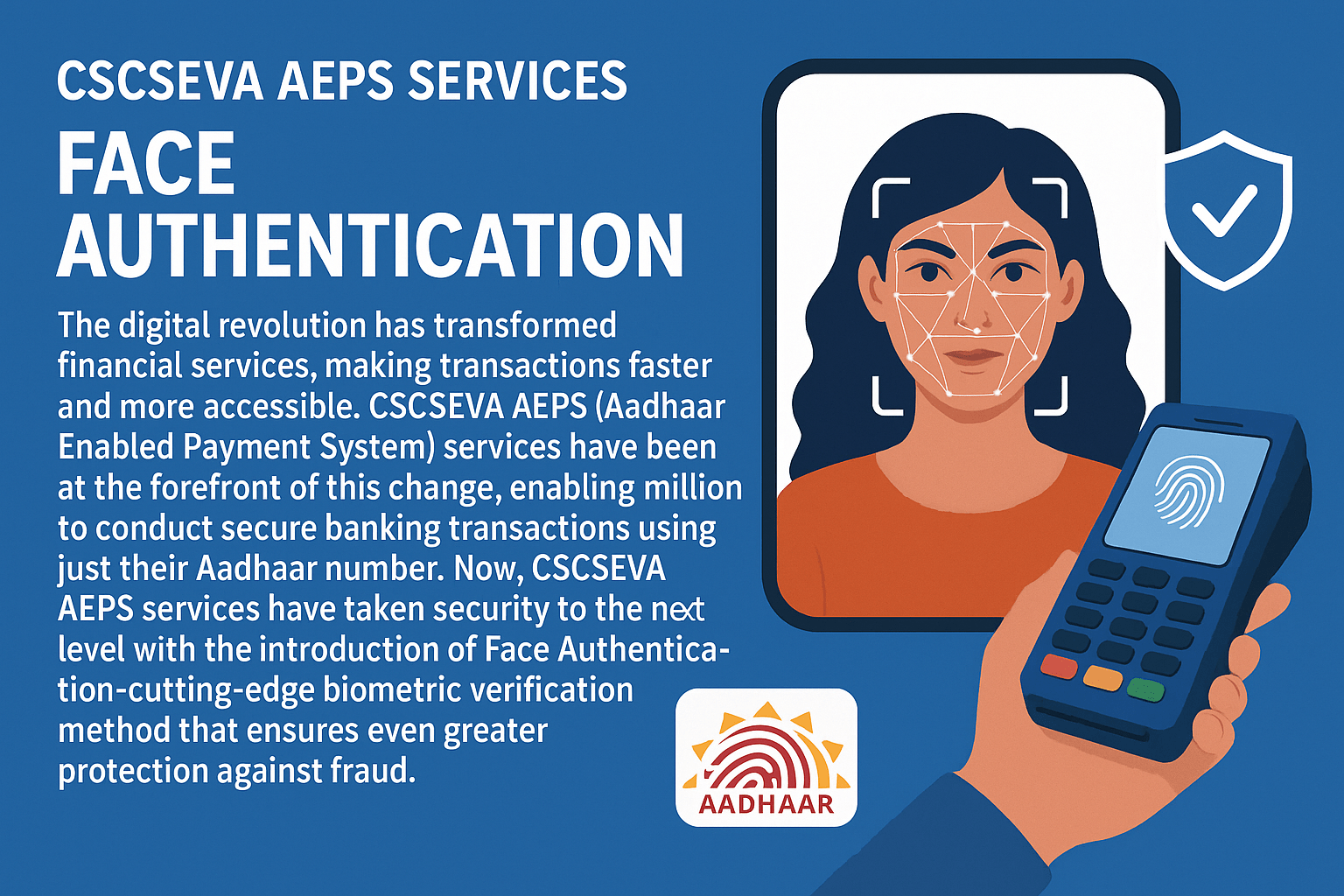The digital revolution has transformed financial services, making transactions faster and more accessible. CSCSEVA AEPS (Aadhaar Enabled Payment System) services have been at the forefront of this change, enabling millions to conduct secure banking transactions using just their Aadhaar number. Now, CSCSEVA AEPS services have taken security to the next level with the introduction of Face Authentication—a cutting-edge biometric verification method that ensures even greater protection against fraud.
In this article, we’ll explore how Face Authentication enhances CSCSEVA AEPS services, why this upgrade matters, and what it means for users. We’ll also address common questions and provide insights into the future of secure digital transactions.
What Is CSCSEVA AEPS?
Before diving into the new security feature, let’s briefly recap what CSCSEVA AEPS services are.
-
AEPS (Aadhaar Enabled Payment System) allows users to perform basic banking transactions—such as cash withdrawals, deposits, and balance checks—using their Aadhaar number and biometric authentication (fingerprint or iris scan).
-
CSCSEVA (Common Service Centre e-Governance Services India) facilitates these services through its vast network of rural and urban kiosks, making banking accessible even in remote areas.
With over 300 million AEPS transactions processed monthly in India, ensuring security is paramount.

The Need for Enhanced Security in AEPS
While AEPS has been a game-changer for financial inclusion, it hasn’t been immune to security challenges:
-
Biometric Spoofing: Fraudsters have used fake fingerprints or silicone molds to bypass authentication.
-
Transaction Disputes: Instances of unauthorized withdrawals have raised concerns.
-
Dependency on Hardware: Fingerprint scanners can wear out or malfunction, leading to failed transactions.
To tackle these issues, CSCSEVA has integrated Face Authentication into AEPS services, adding an extra layer of security.
How Face Authentication Works in CSCSEVA AEPS
Face Authentication is a contactless, AI-powered biometric verification method that uses facial recognition to confirm a user’s identity. Here’s how it enhances CSCSEVA AEPS services:
1. Dual-Layer Security
Previously, AEPS relied solely on fingerprint or iris scans. Now, users can opt for Face Authentication + Fingerprint/Iris for a two-step verification process, drastically reducing fraud risks.
2. Liveness Detection
The system uses AI-based liveness detection to ensure that the face being scanned is real—not a photo, video, or mask. This prevents spoofing attempts.
3. Faster & More Reliable
Unlike fingerprint scanners that may fail due to poor skin conditions, facial recognition works seamlessly in most environments, reducing transaction failures.
4. Inclusive for All Users
Elderly individuals or laborers with worn-out fingerprints often face authentication issues. Face Authentication eliminates this barrier, making banking more inclusive.
Why This Upgrade Matters
The introduction of Face Authentication in CSCSEVA AEPS services is a significant milestone because:
✅ Reduces Fraud: Makes it nearly impossible for imposters to bypass security.
✅ Improves Accessibility: Helps users who struggle with fingerprint authentication.
✅ Enhances Trust: Encourages more people to adopt digital banking.
✅ Future-Ready: Aligns with global trends in biometric security.
According to a 2023 report by the Reserve Bank of India (RBI), biometric fraud in AEPS transactions dropped by 67% in pilot regions where Face Authentication was tested.

How to Use Face Authentication in CSCSEVA AEPS
Using this new feature is simple:
-
Visit a CSCSEVA kiosk offering AEPS services.
-
Select Face Authentication as your preferred verification method.
-
Look into the camera for a quick scan.
-
Complete your transaction securely!
Frequently Asked Questions (FAQs)
1. Is Face Authentication mandatory for CSCSEVA AEPS?
No, it’s an optional security upgrade. Users can still rely on fingerprints or iris scans.
2. What if Face Authentication fails?
The system will prompt an alternative method (fingerprint/OTP) to ensure seamless transactions.
3. Is my facial data safe?
Yes, UIDAI (Unique Identification Authority of India) ensures that biometric data is encrypted and stored securely.
4. Will this slow down transactions?
No, Face Authentication is designed to be as fast as fingerprint scanning—often completing in under 2 seconds.
5. Where is this feature available?
Currently rolling out nationwide, with priority in high-fraud areas. Check with your nearest CSC center for availability.
The Future of Secure Digital Transactions
The integration of Face Authentication in CSCSEVA AEPS services marks a leap forward in financial security. As AI and biometrics evolve, we can expect:
🔹 Voice Recognition as an additional layer.
🔹 Blockchain-based verification for tamper-proof transactions.
🔹 Expansion to other government services beyond banking.
With these advancements, CSCSEVA is setting a new standard for secure, inclusive digital payments in India.
Final Thoughts
The upgrade to Face Authentication in CSCSEVA AEPS services is more than just a security enhancement—it’s a step toward a fraud-free, accessible, and futuristic banking ecosystem. Whether you’re a rural beneficiary or a tech-savvy urban user, this feature ensures your transactions remain safe and hassle-free.
Have you tried Face Authentication with CSCSEVA AEPS yet? Share your experience in the comments!
Disclaimer
This post is for educational purposes only. If you have any concerns regarding the content, please visit our DMCA page for guidance on post removal. Verify ownership or issues related to this post through official channels.
